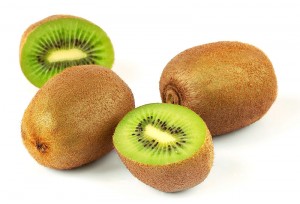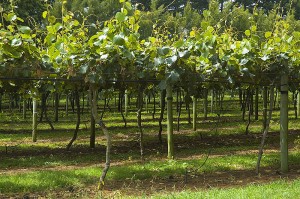 Kiwi fruit, the edible fruit of Actinidia Deliciosa, and hybrids between this species and others in the genus Actinidia. The Actinidia is native to North East Asia, particularly South China. Kiwifruits owe their name to the national bird of New Zealand, named “kiwi”, a small, brown and furry, like the fruit. They are now extensively grown in New Zealand, Australia South America and even Italy and France.
Kiwi fruit, the edible fruit of Actinidia Deliciosa, and hybrids between this species and others in the genus Actinidia. The Actinidia is native to North East Asia, particularly South China. Kiwifruits owe their name to the national bird of New Zealand, named “kiwi”, a small, brown and furry, like the fruit. They are now extensively grown in New Zealand, Australia South America and even Italy and France.
Also known as the Chinese gooseberry, the fruit consists of a hairy, brown peel containing green flesh, with white pulp in the center, surrounded by black, edible seeds. The fruit has a sweet taste, similar to a mixture of banana, pineapple and strawberry. Kiwi fruits are native to China, where they were called “macaque peach”.
The most common cultivars of kiwifruit are oval, about the size of a large hen’s egg (5–8 cm and 4.5–5.5 cm in diameter). Nutrition-wise, kiwi fruits contain about as much potassium as bananas, and also contain 1.5 times the DRI for Vitamin C. It is also rich in Vitamins A and E, and its black seeds can be crushed to produce kiwi fruit oil, which is very rich in Alfa-Linoleic Acid (an important Omega-3 essential fatty acid). Studies have proven that kiwifruits are useful in improving conditions of asthmatic children, and in decreasing the probability of colon cancer by providing a good amount of dietary fiber.
How to grow Kiwifruits
Growing Requirements
Kiwifruit vines are fairly hardy and grow in a wide range of temperatures, but to produce satisfactory fruit they need:
- well-drained, fertile soils
- shelter from the wind
- adequate moisture year-round
- protection from autumn and spring frosts.
Soils
The deep, yellow-brown loams of the Bay of Plenty are well-drained, but need regular nitrogen, phosphorus and potassium once the vines begin cropping. Orchards are usually fertilized in spring and early summer with 200 kilograms of nitrogen, 55 kilograms of phosphorus and 100–150 kilograms of potassium per hectare.
Shelter
Wind is a major limiting factor in establishing a kiwifruit orchard and growing high-quality fruit. Young and flowering shoots are easily damaged, and most orchards need protection from persistent winds. In the 1970s and 1980s growers planted shelter belts of fast-growing trees, but increasingly they are building artificial windbreaks using polythene fabric.
Irrigation
Kiwifruit orchards need irrigation in summer. Elsewhere, young vines usually benefit from irrigation. Growers use water sprinklers and wind machines to protect their crop.

The Orchard
Kiwifruit is grown in orchards that are almost exclusively devoted to the one fruit. This differs from other countries, where kiwifruit is grown along with a number of other fruits.
Support Structures
Vines are grown and trained on supports – either a pergola or T-bar. Vines need to be pruned, otherwise they become a tangle of unproductive, leafy shoots.
Planting Layout
The vines are planted out in rows some 3–5 meters apart, depending on the type of support, and with a spacing of 5–6 meters between plants in a row. To ensure pollination, male plants are distributed through the orchard, with male to female plant ratios around 1:5.
Pests
For the first decades of its cultivation, Kiwifruit was virtually pest-free. But as the area of vines increased, leaf-roller caterpillars, scale insects and mites began to attack. Various species of leaf-roller feed on the leaves and scar the fruit, with the brow headed leafroller (Ctenopseustis obliquana) the most common. Greedy scale insect (Hemiberlesia rapax) sucks the sap of young plants and can infest the fruit. Kiwifruit with signs of greedy scale are not accepted for export.
Diseases
Root rots can develop from infection by Phytophthora soil fungi, especially on poorly drained sites. The native bootlace fungus Armillaria novaezelandiae spreads to kiwifruit from infected dead tree stumps or buried wood and causes fatal infections. In humid climates, grey mold Botrytis cinerea rot infects flowers and young fruit.
The Growing Season
The kiwifruit year starts after the previous season’s harvest, when the vines drop their leaves and enter winter dormancy. Growers prune fruited and surplus canes. Dormancy lasts until late August, when buds begin to swell. Bud break, shoot growth and flowering occur in spring. The timing and extent of these depends on how cold winter was – chillier winters usually lead to more profuse flowering. However, prolonged freezing temperatures in winter, and spring and autumn frosts, can harm kiwifruit production.
Pollination and Fruiting
In early summer, flowers are pollinated and thinned. Kiwifruit are not self-pollinating, so part of each orchard must be devoted to male vines unless pollen is brought in for artificial pollination. Unlike most other fruits, kiwifruit need high levels of pollination (about 13,000 pollen grains per stigma compared to only 12 grains for apple flowers). Growers either place numerous honey-bee hives in the orchards temporarily, or artificially pollinate the flowers.
Throughout summer the main tasks are to remove damaged or misshapen fruit, prune excessive vine growth to maintain fruit health, and control pests and diseases.
Harvesting
Historically, kiwifruit harvesting was timed using a Brix test to determine the amount of sugar in the fruit. Orchardists now also use dry matter and color tests to ensure harvested fruit has the desired eating qualities. Most fruit is picked in May. Since the mid-1990s, fruit from some early-maturing orchards has been picked for early shipments under the Kiwi Start program.
Fruit is picked by hand and put into bags, which when full are emptied into large wooden bins.
Packing and Storing
The bins are taken to pack houses, where most of the kiwifruit is graded, packed into trays then placed in a cool store. A small proportion of fruit is kept in bins for cool storage, or in some cases storage in a controlled atmosphere, and is packed later.
Kiwifruit is sold from April to the end of December, with supplies taken out of cool storage near the end of the season.
Sources: kiwi-fruit.info, Wikipedia.org, www.teara.govt.nz; Photos: Wikipedia.org